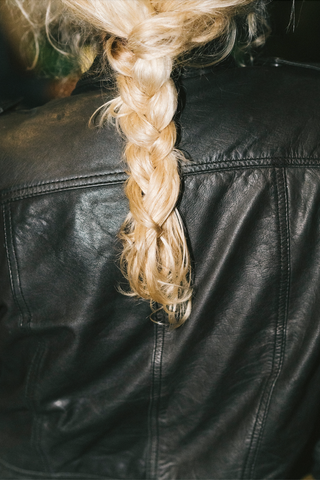How to clean a thrifted leather jacket

Leather jackets are a fall essential, but buying new is not great for the planet. Learn how to clean a leather jacket, in case your thrifted find has a wee stain.
Leather jackets are the perfect item to thrift for the transitional weather of fall. But sometimes they have minor stains or scuffs that turn buyers away. We are going to explain how to clean a leather jacket and maintain it for years to come.
But first, did you know that buying a new leather jacket is super harmful for the environment?
- The livestock industry is responsible for nearly 15% of human-induced greenhouse gas emissions and contributes significantly to deforestation.
- The processing of leather also impacts the environment, with 300kgs of chemicals being added for every 900kg of animal hides tanned.
- That’s over 60 full bathtubs worth of water to make 1kg (2.2 pounds) of leather.
Leather is also a part of the livestock industry, which accounts for 15% of the world’s carbon dioxide emissions and drives deforestation in the most biodiverse regions of the world.
This is why we suggest you buy and wear used and/or thrifted leather jackets. Read our guide to keeping leather jackets clean below.
Before we get to that, if you love the look of leather details on classic jacket styles, check out our Classic Varsity Jackets with durable leather sleeves.
How to clean leather jackets

Leather is very durable, yet ridiculously sensitive to cleaning products. Cleaning leather is a little complicated because you shouldn’t use bleach or ammonia-based products. Using too much water can also leave a stain. Unfinished leathers like suede and nubuck require different cleaning methods from finished leather, and you should probably take them to a professional.
Most leather jackets are made from finished leather. Keep in mind that it’s easy to scratch leather and even wear off its finish. Always use a soft cloth like an old cotton t-shirt to clean your leather jackets. Here are some techniques to try at home.
Non-oil stains
Blot with damp cloth and condition - Blotting with a damp cloth can help the stain start to disappear. Dry any moisture and once the leather is dry apply leather conditioner.
Leather cleaner and damp cloth - If your stain doesn’t disappear with water alone, it’s time to bring in some cleaner designed for leather. The important thing is to spray a cleaning cloth with the cleaner. Don’t apply it directly to the leather.
Apply your cleaner to the dirty parts of your jacket. Next, use a different slightly damp cloth to clean off the remaining cleaner and any moisture. Let your coat air dry away from sun or heat, which can dry out the leather.
Oil and grease stains
Microfiber cloth - For fresh stains, first try the gentlest method. Sometimes a microfiber cloth will lift the oil from the leather and prevent a stain.
Cornstarch or baking soda - Dry powders like cornstarch or baking soda can lift oil stains on leather. First, apply the cornstarch to the stain and let it sit for a few hours or overnight, then dust off the cornstarch or baking soda with a soft brush or vacuum the spot to lift the oil away from the jacket.
More DIY methods

These cleaning methods are DIY at your own risk. Some of them are too harsh for delicate leathers, so they’re not recommended. However, if you don’t want to pay for professional cleaning, it may be worth it to test them on a small patch of the leather first.
- Lemon juice - This method can work for wine stains. Apply by blotting over the stain with a cleaning cloth or cotton swab. Blot dry with another cleaning cloth.
- Non-gel toothpaste - apply to the stain, let it dry out, then remove with a cleaning cloth. Do not wipe the toothpaste over other parts of the jacket.
- Rubbing alcohol - reserve rubbing alcohol for ink stains only. Apply by blotting over the stain with a cleaning cloth or cotton swab
Professional leather cleaning: Some stains are best left to professional cleaners. Consider using a professional for glue, ink, makeup, paint, or any stain on unfinished leather.
Leather care tips

Store leather properly: Keep your leather goods longer by storing them properly.
- Use a heavy-duty jacket hanger to support the weight.
- Hang them in a dry place away from sunlight or moisture.
- Use a garment bag to avoid scuffs or scratches from the other coats in your closet.
Apply leather conditioner: Leather conditioner keeps leather soft and flexible over time. Apply a conditioner with a soft cloth to your leather goods every 6 months. Check the label of your conditioning product to make sure it’s a good fit for your leather type (finished vs unfinished).
Waterproof your leather: If you’re worried about water damage, try waterproofing your leather with a chemical spray designed for your leather type, or this DIY beeswax method.
Pair your thrifted leather jacket with Goodfair’s latest arrivals:
